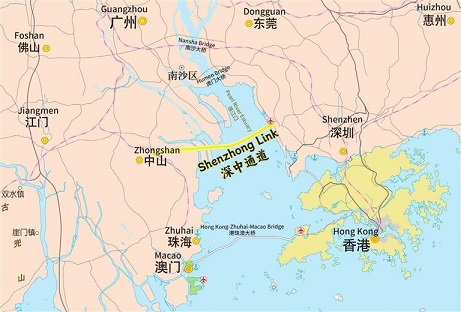Shenzhen
 2024/6/26
2024/6/26
 source: Shenzhen Daily
source: Shenzhen Daily
 Print
Print

Graphic by Han Shuang

A lighting market in Guzhen Township, Zhongshan. Dubbed as China’s lighting capital, Guzhen, sprawling over an area of 50 square kilometers, commands an impressive 70% of China’s lighting market. Its products are exported to over 130 countries and regions. Liu Xudong
Liu Minxia
mllmx@163.com
THERE is at least one iconic bridge in each of the world’s major bay areas. The San Francisco-Oakland Bay Bridge in the United States’ San Francisco Bay Area, the Tokyo Gate Bridge in Japan’s Tokyo Bay, and the Brooklyn Bridge in the New York Bay Area are all well-known for the irreplaceable roles they play in connecting regions, improving transportation, and stimulating economic development.
In China’s Guangdong-Hong Kong-Macao Greater Bay Area (GBA), where nine constituent cities in Guangdong line both banks of the Pearl River Estuary, a 24-kilometer cross-sea passage is bridging the geographical divide. The Shenzhong Link will foster collaborative growth and boost integration by significantly improving connectivity within the GBA.
Bridging the gap
The nine cities —Guangzhou, Shenzhen, Dongguan, Huizhou, Zhuhai, Zhongshan, Jiangmen, Foshan, and Zhaoqing — vary greatly in their industrial capabilities and resources.
Cities on the eastern side of the Pearl River Estuary, such as Shenzhen and Dongguan, are strong in high-tech innovation, advanced manufacturing, supply chains, and talent attraction, but are increasingly facing bottlenecks such as rising costs and limited land space.
Those on the western side, like Zhongshan and Jiangmen, have a comparative advantage when it comes to the cost of land. For instance, in Zhongshan, office, factory, and shop rentals are only one-eighth the cost of those in Shenzhen. However, these cities lag behind in development and require industrial upgrades.
With the opening of the Shenzhong Link, GBA cities will form a closely connected city cluster characterized by a smooth flow of production factors, including personnel and capital, and each city will play a distinct role based on its resources and development stage, according to Prof. Wang Guowen, director of the China Development Institute’s research center for logistics and supply chains.
“As a demonstration area of socialism with Chinese characteristics, Shenzhen requires a robust industrial hinterland, as facilitated by the opening of the Shenzhong Link, to continue advancing in cutting-edge fields and competing globally,” Wang said.
Zhongshan, on the other hand, is poised to embrace a rapid transformation and upgrading of its traditional industries, according to Qu Decheng, executive vice president of the Zhongshan Lighting Electrical Appliance Industry Association. “The two cities are very complementary in this endeavor,” said Qu.
A number of Shenzhen companies have expanded their operations to cities on the western side to increase capacity.
Shenzhen CGN Research Institute Co. has invested 2.5 billion yuan (US$344 million) in a research center in Zhongshan to commercialize its technologies. Other companies, such as BYD, Unilumin Group Co., and Express Luck Technology Ltd., have relocated some of their manufacturing facilities to Zhongshan, with total investment surpassing 50 billion yuan. Construction is set to commence on 13 Shenzhen companies’ projects in Zhongshan this year, with a planned investment of 5.48 billion yuan.
Some companies have expanded even further west. Shenzhen Top-Peak Electronics Co. has invested 30 million yuan to establish a base in Jiangmen, aiming for the agricultural UAV market in western Guangdong and even Guangxi.
Many of the companies settling in the HiTrom Hans intelligent manufacturing park in Shunde are from Shenzhen, according to Li Kai, general manager of the park. “The Shenzhong Link will make it easier to travel to Shunde from Shenzhen and Dongguan, which will enable companies to keep their R&D in Shenzhen and relocate their manufacturing to Shunde,” said Li.
Chen Rongping, professor at the Guangdong Academy of Social Sciences and executive vice president of the South China Urban Research Association, stated that the Shenzhong Link will enhance integration among cities even beyond the GBA, thereby creating collaborative growth between eastern and western Guangdong.
More opportunities
“The opening of the Shenzhong Link will create numerous opportunities for cities on both sides,” said Wang from the China Development Institute.
In 2023, the 66-square-kilometer Shenzhen-Zhongshan Economic Cooperation Zone, the first of its kind in the Pearl River Estuary area, was unveiled in Zhongshan’s Cuiheng New Area as an experimental base for exploring new paths of cross-city collaborations.
Moreover, areas for industrial partnership are emerging. In April this year, Shenzhen and Zhongshan launched a low-altitude industry alliance, with Shenzhen focusing on R&D and Zhongshan on manufacturing.
Tourism is another sector that presents substantial growth potential. “The Shenzhong Link will bring GBA cities within a one-hour travel radius that encompasses over 25 million consumers. Previously, Shenzhen residents needed three to four hours to reach western Guangdong via the Humen Bridge or Nansha Bridge, which deterred many tourists,” said Huang Chuping, assistant to the general manager of the Shenzhen Each Travel Chuangjing International Travel Agency. With plans to open a branch in Zhongshan by the end of this month, the agency is actively seizing opportunities by designing tourism packages that cover not only Shenzhen and Zhongshan, but extend westwards to Foshan, Jiangmen, Zhuhai, and Yangjiang.





